Implementing Lean tools in the Service Desk command
Prehistory
 Any service for end users must be flexible, reflecting their current needs. Business is developing, the quality of service should also grow. If this does not happen, sooner or later the level of services specified at the start of the project ceases to suit consumers. Therefore, I want to share with you my experience in introducing new working methods in our Service Desk (SD) team.
Any service for end users must be flexible, reflecting their current needs. Business is developing, the quality of service should also grow. If this does not happen, sooner or later the level of services specified at the start of the project ceases to suit consumers. Therefore, I want to share with you my experience in introducing new working methods in our Service Desk (SD) team.At the end of 2012, we launched the SD service for one of our clients 24/7/365. The customer did not have a full-fledged SD service before, all support was provided by internal units. A new team consisting of 7 employees, including me, was selected and trained for this project. Service started actively - the transfer of knowledge, familiarity with the specifics of the work. The team had a lot of ideas and enthusiasm. Service earned like a clock.
Why is it difficult to provide good service without a change in work?
The composition of the team did not change much over 3 years. Anyone familiar with the work of SD, that is how much. Over time, enthusiasm began to fade, routine tasks swallowed the team, and involvement in the project declined.
')
The final straw was the feedback received from the client about the low quality of our service. According to its results, it became obvious that employees were not fully immersed in the work of the project and did not use their experience to improve support processes, and these qualities are vital for competingly capable technical support.
It is time to change the approach of the team to the service provided. In this vein, Lean tools have come to us, which have proven themselves in our company for several years.
What is Lean?
Lean manufacturing (from the English. Lean production, lean manufacturing - "well-balanced production") - the concept of managing a manufacturing enterprise, based on the constant desire to eliminate all types of losses. Lean manufacturing involves the involvement in the process of optimizing the business of each employee and the maximum customer focus.
Lean approach in our company is a set of tools and principles that help shape and maintain a culture of continuous improvement.
The principles of the Lean approach are as follows:
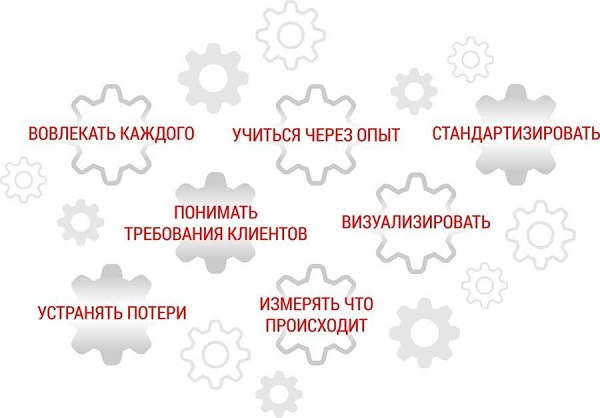
Tools and techniques that we already use at the company level:
- Communication Cell, or quality circles, is a team meeting with a clear program, an effective format for internal communication.
- Demand analysis - a way to search for trends in incoming calls (for example, incidents) to reduce their number.
- Problem solving session - identification of root causes of incidents and team development of measures to eliminate them.
- Workplace organization - optimization of physical and virtual work space.
- Value stream mapping is a tool for optimizing workflows based on their detailed analysis.
To quickly remedy the situation on the project, we selected the following tools:
- “Quality Circles” - to involve the whole team in the process of improving the service, visualizing the current performance indicators of the service, collecting feedback.
- Demand analysis - assessment of current trends in the service, the reasons for appeals, the definition of areas of increased labor costs by the SD and the client.
- Problem solving session - to develop actions to achieve new service targets, reduce labor costs, improve work efficiency.
- Workplace organization - for the reorganization of the knowledge base and file storage, which will lead to a reduction in the time spent on finding the information necessary to solve requests.
The implementation of tools on the project was divided into three stages:
- Launch of "quality circles".
- Practical use of tools to identify, solve problems.
- The organization of a virtual workplace
Launch of "quality circles"
Quality Circles is a platform for effective communication. This is a structured format for the interaction of the team to discuss all relevant issues, arising difficulties in the work, risks. Information for discussion is visualized and posted, as a rule, on marker boards.
For geographically distributed teams, you can use the electronic version. We began to meet weekly in an open format.
Despite the need for these changes, the first thing we encountered was resistance from the team. The staff did not want to take part in the meetings because they did not see the point in them. Therefore, our task was through the “quality circles” to show the team how it works, where it moves and what needs to be paid attention to. Tell about the benefits that may be, for example, reducing the cost of processing requests, automate routine tasks, optimize internal processes.
The principle of involving everyone implies the participation of all employees in the team’s proactive work. This is achieved, among other things, through the distribution of tasks in preparation for meetings. Each employee is assigned a certain activity. At the first stages, the task of preparing and conducting quality circles was carried out only by the coordinator, and the correct solution was the gradual involvement of each team member.
Gradually, interest in meetings grew.
Each employee had the opportunity to openly discuss with the team his ideas and suggestions. If they took time to work out, they were fixed in a special section, they set deadlines for consideration. Further, based on the results of the general discussion, they were taken to work or transferred information to the client for internal analysis.
One of the objectives of the “quality circles” is to maintain the focus of the team on predetermined performance indicators. Properly selected indicators help to focus on what is important for the client. Each indicator has a target value to reach, agreed with the client. Indicators can be both internal, aimed at improving the work within the team, and external, aimed at improving the quality of the service provided.
The first task of the team was to focus on the number of errors that occurred when filling out the application card in the ITSM system. To determine the root causes of the applied teamwork tool - the problem solving session (problem solving session).
Problem solving session
When solving team problems, all employees should be involved in the process of finding a solution, since final decisions taken without the participation of the whole team are likely not to be taken seriously.
The tool is quite simple and consists of six stages:
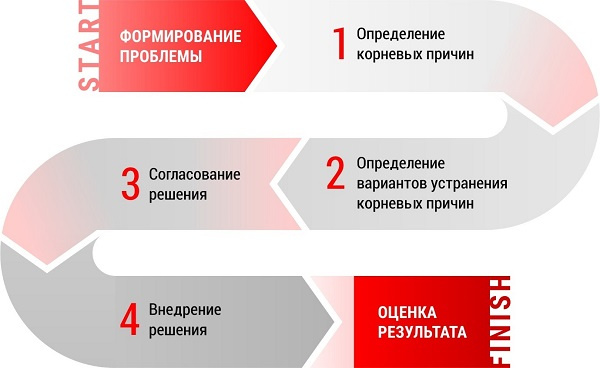
I'll tell you a little about each stage:
- In our case, the problem was one of the performance indicators, which went beyond the boundary values.
- To determine the root causes, we spent "silent" brainstorming. Each employee recorded in his opinion all the factors affecting the appearance of errors in the work.
- Then we distributed all the options across the 4 zones and chose those options, the implementation of which would give us the maximum effect at the lowest cost.
- Together with the team leader, they formed an implementation plan, which was evaluated weekly at the quality circles. The deadline for achieving the goal can be both a month and a year. It depends on the complexity of the indicator, factors affecting its formation. For example, the competence of the team in a particular area, technical knowledge, etc. We have chosen half a year.
- We determined the steps in accordance with which we began to systematically move towards the achievement of the goal.
- At the intermediate stages, the trend was assessed, and, if necessary, corrective procedures were performed.
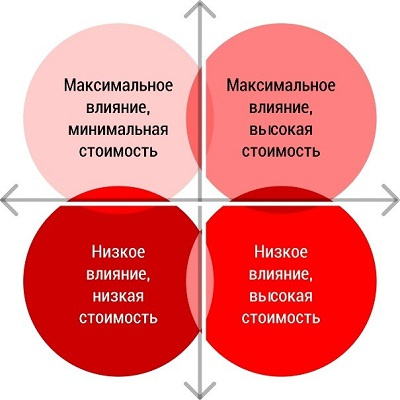
For six months, the percentage of errors in completing the card of appeal was reduced from 17% to a stable level of 0.8-1% in relation to the total number of closed requests.
We visualized the achieved values:
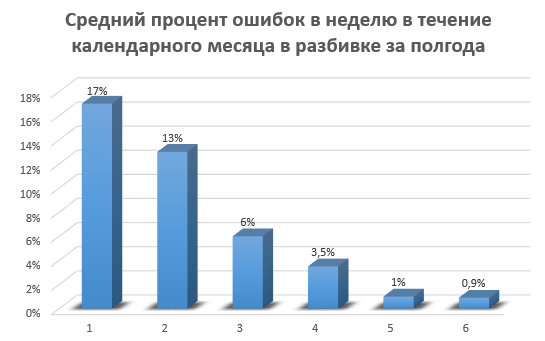
Having received a positive experience with an emphasis on working at a particular indicator, we went further.
The next goal was to increase the percentage of calls resolved on the first line without transferring them to the next (First time fix, FTF). For the analysis of incoming calls and the determination of potential, which can be closed on our line, we used a tool for the identification of trends (demand analysis).
Running a trend detection tool
It should be noted that one of the key success factors in the analysis is the correct classification. We did the unloading of user requests to the Service Desk, which were transferred to the decision on the second support line (the data below were chosen as an example, the original punctuation is preserved). For a more thorough analysis, you can separate all requests for service requests and incidents.
Sorted them by quantity:

Next, build a Pareto chart.
The Pareto Chart is a tool that allows you to distribute efforts to resolve emerging problems and identify the root causes from which you need to begin to act.
The Pareto principle (principle 20/80) means that 20% of the efforts give 80% of the result, and the remaining 80% of the efforts - only 20% of the result.
The Pareto principle (principle 20/80) means that 20% of the efforts give 80% of the result, and the remaining 80% of the efforts - only 20% of the result.

Focus on our 20%.
Select the treatment, which are located on the left to the intersection of the green line with the red. In this case, we see that the majority of calls are related to software installation, problems with the "Office", access to network resources, connecting to a shared box, and adding to the distribution group. It is clearly worth paying attention to and analyzing in more detail.
After receiving these results, we conducted a regular brainstorming session with the team, which resulted in what we lack to solve such appeals on the first line.
At the start of the counting, the percentage of applications closed on the first line was 13%. Six months later we received the result of 23%. Virtually every 5 calls were closed on the SD side.
For the client, this translates into a reduction in the labor costs of the second line of support.
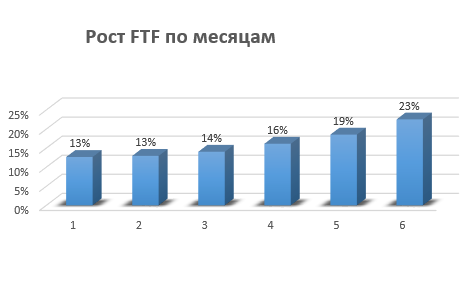
The organization of the virtual space (Workplace organization)
For productive and high-quality work on appeals, not only a conveniently organized physical workplace, but also a virtual one is necessary. During the work of the project, many tools have been tried to store information, ranging from a txt file, excel, local file resources and ending with sharepoint.
What has become for us an organized virtual workplace: all project information is distributed so that any old or new employee spends no more than a minute searching for the necessary data.
What are the benefits of this change?
- less time to search for information, therefore reducing the processing time of treatment;
- information is standardized and visually easily distinguishable;
- incoming data flow is easy to manage.
To restore order in the information space, we used the 5S approach consisting of five stages:
- Sift (screening);
- Sort (sorting);
- Shine (highlighting);
- Standardise (standardization):
- Sustain (maintenance).
Sift, Sort, Shine are designed to change, and Standardise and Sustain are designed to maintain and verify compliance with standards, respectively.
 Sift: we analyzed all of our design information storage sites for obsolete or unused data. All unnecessary information was moved to the appropriate folder "Archive" on each resource. All instructions, documentation stored on local computers were shared with the team and also analyzed. This allowed us to estimate the total amount of accumulated knowledge on the project. Information requiring clarification was flagged and gradually cleared. The project uses 7 different resources containing multifaceted information.
Sift: we analyzed all of our design information storage sites for obsolete or unused data. All unnecessary information was moved to the appropriate folder "Archive" on each resource. All instructions, documentation stored on local computers were shared with the team and also analyzed. This allowed us to estimate the total amount of accumulated knowledge on the project. Information requiring clarification was flagged and gradually cleared. The project uses 7 different resources containing multifaceted information. “Sort” launched the process of redistributing all relevant information in accordance with its type. Duplicate files have been deleted.
“Sort” launched the process of redistributing all relevant information in accordance with its type. Duplicate files have been deleted. “Shine”: together with the team, they identified a new file structure of the repositories, as well as those responsible for entering and changing information.
“Shine”: together with the team, they identified a new file structure of the repositories, as well as those responsible for entering and changing information. Standardise: created an internal standard for storing and distributing incoming information. Name of files and folders, categories of information, periods of mandatory data update.
Standardise: created an internal standard for storing and distributing incoming information. Name of files and folders, categories of information, periods of mandatory data update. Sustain: application of the developed standards and approaches in the course of providing the service. Checking the compliance of new standards with the work operations. This allowed us to form a new approach to the storage, distribution, updating of information.
Sustain: application of the developed standards and approaches in the course of providing the service. Checking the compliance of new standards with the work operations. This allowed us to form a new approach to the storage, distribution, updating of information.In conclusion, I want to say that thanks to these simple tools, the team managed to regain the trust of the client and significantly improve the quality of the services provided without increasing labor costs.
For the client, the changes became noticeable in a point correction of problem areas, a decrease in the number of incidents, a reduction in the time to resolve requests, and recommendations received on optimizing internal IT processes.
Material on the topic .
Source: https://habr.com/ru/post/330372/
All Articles